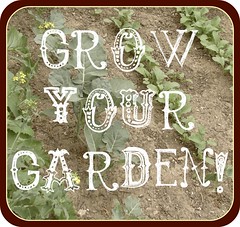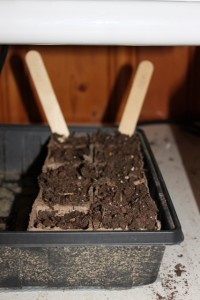 There are oodles of books about starting seeds from people far more qualified than me to be dispensing advice. If you really want to know everything, I suggest searching out references at your local library.
What we do here is a casual process guided mostly by the backs of the seed packets and our own yearning to be outside.
There are oodles of books about starting seeds from people far more qualified than me to be dispensing advice. If you really want to know everything, I suggest searching out references at your local library.
What we do here is a casual process guided mostly by the backs of the seed packets and our own yearning to be outside.
Indoors we will soon start some peppers, tomatoes, and herbs. Our setup is a simple plastic tray with peat pots and a hardware store fluorescent light suspended on top.
As soon as we can work the soil, around the end of March, we will sow potatoes outdoors in our potato tower (post in progress). Peas, shallots and greens will come soon after in early april. Greens can be started indoors but with our limited seed starting space we just start them outside.
This year we'll add asparagus to the garden and sow the crowns sometime in mid April. They need deep and well drained furrows according to the OSU extension fact sheet. The extension publishes fact sheets on most varieties of home garden vegetables and are worth a look. They are hybrid and chemical proponents, so just ignore that advice if you are going for a more natural approach.
Everything else will be direct sown around May 1. The traditional frost free date is May 15, but I am usually willing to take the risk by May 1. I cover beds with old sheets for the night if there is a late frost.
 Direct sowing is one of Lil's favorite garden projects. She is good at punching her finger down to make holes and covering the seeds back up. We label rows with old plastic silverware, popsicle sticks, or whatever else is available. I lust after reusable metal row markers.
Direct sowing is one of Lil's favorite garden projects. She is good at punching her finger down to make holes and covering the seeds back up. We label rows with old plastic silverware, popsicle sticks, or whatever else is available. I lust after reusable metal row markers.
Around mid May there's an inevitable trip to the garden center and we can never seem to resist buying a few more seedlings. This year we plan to visit Jon Fisher tomato greenhouse on the recommendation of neighbors to add some variety to our tomato plantings.
We sow many seeds two or three weeks in a row to extend their production. Peas, squash, beans, carrots and greens are all good candidates for this. In the fall after early season vegetables (peas, broccoli, greens) have gone by, we will sow late season vegetables like carrots, beets, chard, kale, and lettuces in their rows.
To keep everything in order, I generally arrange seed packets in a box based on their planting date. I put them at the back of the line after they are planted.
A friend just shared this awesome planting calendar calculator. I will probably print a copy for the seed packet box so I don't have to keep everything in my head.
What's your seed starting plan?
 I have had leek and celery packets in my seed stash for two years now. By the time I'm starting all the other seeds I realize I am too late for those.
This year, Kate shared a perpetual garden calendar that reminded me I can start leeks indoors now. By the way, I totally covet that calendar! The seeds will grow under lights for 10-12 weeks to be transfered outside before the last frost date of May 1.
I have had leek and celery packets in my seed stash for two years now. By the time I'm starting all the other seeds I realize I am too late for those.
This year, Kate shared a perpetual garden calendar that reminded me I can start leeks indoors now. By the way, I totally covet that calendar! The seeds will grow under lights for 10-12 weeks to be transfered outside before the last frost date of May 1.

 Direct sowing is one of Lil's favorite garden projects. She is good at punching her finger down to make holes and covering the seeds back up. We label rows with old plastic silverware, popsicle sticks, or whatever else is available. I lust after reusable metal
Direct sowing is one of Lil's favorite garden projects. She is good at punching her finger down to make holes and covering the seeds back up. We label rows with old plastic silverware, popsicle sticks, or whatever else is available. I lust after reusable metal 
